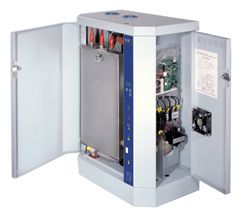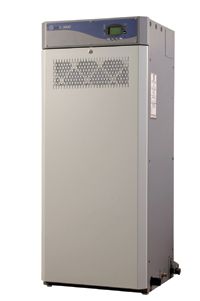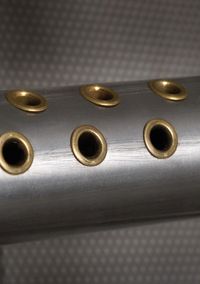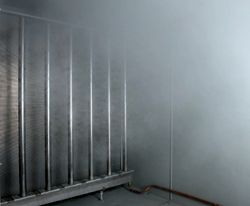Dry saturated steam can only be produced under pressure. Open-ended boilers, another term for this type of atmospheric device, are not required to deliver dry saturated steam for humidification hence they are relatively low technology. There are a number of devices available on the market today: electrode, resistance and gas-fired boilers.
The electrode boiler is the most common system adopted today. These are generally the cheapest first cost option for producing steam for humidification. They have a tendency to be expensive to run and maintain, partly due to the fact that they operate most effectively on raw mains water, which has a limiting affect on the cylinder life.
The polypropylene cylinder, which is the heart of this system, can be either disposable or split for cleaning. The cylinder life is totally dependent on the quality of the water on site and the operational time. Typically, water in the south of England would be mineral rich and electrode boiler cylinders would last between one to three months. In contrast, Lancashire and Scotland have predominately soft, mineral free water and a cylinder could last all season.
Calcium in the water is deposited onto the electrode or in the bottom of the cylinder and is too big to be flushed away during the periodical drains. It stays and builds up until it fills the cylinder and there is no more room for the water. The softer the water the better for cylinder life.
The down side of this soft or low conductivity water is that it may take some time for the water to be heated and the boiler brought up to capacity.
The conductivity has to be built up over a period of time, which would be by the action of boiling the water and leaving whatever sediment there is within the cylinder.
Sediment can be introduced: an Alka-Seltzer tablet is favoured by a lot of engineers. This will certainly increase the conductivity immediately but if the system calls for a major drain, which then requires a re-fill of new raw water we are back to square one.
Changing the voltage configuration from single- to two-phase with a new cylinder configured for this arrangement is a more permanent solution. The owner/operator would need to seek the advice and help of the original equipment manufacturer to instigate this solution.
There will always be exceptions to this example as there are a number of variables that must be considered:
• Actual source of water
• The actual water quality
• Further water treatment that is site-specific
• The operational time for the cylinder.
• Maintenance periods
• The type and design of the air conditioning system
In recent years the biggest problem has been the variable nature of the raw water supplied to the same site. Local water authorities will give the building owner a typical water quality analysis for the site. Knowing the hardness and conductivity which can be expected will help in selecting the right plant for the application.
The choice of disposable or splitable cylinders is down to available time. It takes 15-30 mins to change a disposable cylinder, including cleaning the pump and valves. It could take an hour to clean the elements of a splitable cylinder in a suitable location before the engineer tackles the pump and valves. In hard water areas this may be required once or twice a month. Time is money and it is the choice of the plant operator/owner.
Electrode boiler devices are available as on/off, stepped and/or fully proportional control to suit the type of application. All units control three basic principles, water feed, boil and drain. Water is fed into the cylinder in response to capacity and the drainage requirement. Drainage is controlled by the conductivity of the water.
As water is boiled it leaves the impurity behind creating a soup or high conductive cocktail. Once the conductivity reaches a pre-set limit a drain cycle will be initiated and, because there is still a load requirement, the cylinder will fill with fresh water. This has to be heated and boiled to generate steam once more. Smart pulsed feed and drain cycles will allow the unit to keep boiling for longer periods.
Capacity control is achieved by either allowing the water to boil away and not replenishing the level or initiating a drain cycle to reduce the amount of water in contact with the electrode. Earth leakage protection legislation requires the power to be switched off when in drain phase. Water regulations require an air gap to be present between the cylinder or boiler and the drain and feed lines.
Resistance heater unit
The resistance heater type system is more expensive to buy than its open-ended electrode alternative, but because they use a resistance heater element to boil water they are not conductivity dependent and therefore can operate using base-exchange-treated water or even de-mineralised water. Using de-mineralised water could produce nominally two years' operation without the need for anything more than a visual inspection, representing a much cheaper long-term option, as maintenance costs are comparatively low.
If fed with hard raw mains water the calcium build-up within the cylinder would be quite appreciable and necessitate frequent cleaning. For this reason, most manufacturers would recommend feeding this device with treated water. Base-exchange water softeners will exchange the solubles from calcium to sulphite. The impurity is still there but it will not amalgamate and can be easily flushed away.
The control of these systems would again revolve around feed, boil and drain. Power can be kept onto the heaters during feed and drain cycles, as there is no fear of earth leakage. Current is not passed through the water; therefore a finer control of the steam production can be achieved. This device is very useful in close control applications.

Resistance element boiler
These applications would tend to use de-mineralised water, which means there would be little or no need for a drain cycle to remove dissolved solids. The cylinder material would be stainless steel or a suitable polypropylene so the aggressive nature of de-mineralised water is negated.
These devices are available in on/off, stepped and fully proportional control, and can be fed by an external control signal from, say, a BMS system or a standalone sensor/transmitter arrangement within the ductwork or the conditioned space.
Gas fired
The gas fired atmospheric steam generator is relatively new to the humidification market. Again, relatively expensive in terms of capital outlay, but because it is not conductivity dependent it can use base-exchange-treated water or de-mineralised.
There are a number of gas types within Europe and each appliance will have the correct approvals for the appropriate country. In the UK we have the luxury of having a uniform quality of mains gas available plus Calor and propane in containers.

Gas-fired boiler
Our legislation requires the correct approvals from certified test houses are in place before any appliance can be offered or installed.
As well as having a gas supply, of the right capacity available there is a need for a flue to remove the fumes of combustion. Straightforward single stack or uncomplicated balanced flue arrangements are available from the humidifier manufacturer or from a flue specialist. If the flue is complicated in any way it is advisable to seek the advice of a specialist manufacturer or supplier. A qualified gas engineer as prescribed by the Gas Safe registration scheme must do any work carried out on the appliance on site.
The same principle of operation and control will apply i.e. feed, boil and drain and the equipment is available as on/off, stepped and full proportional control.
All three devices should have an antifoaming device within its control logic.
Foaming occurs at a point when the chemical contaminates in the cylinder get to such a high concentration that soap-type bubbles appear. If allowed to persist arcing will occur within the electrode boiler and create possible water carryover into the air path. Resistance and gas-fired systems will experience water carry-over or heater failure due to low water levels. Basically the foam fools the control sensor that the cylinder contains water when it doesn't. One way of overcoming foaming is to measure the water conductivity and when it gets too high initiate a drain and fill to dilute the contaminates. This control and monitoring strategy is contained within the appliance control architecture.
All three devices have the ability for master/slave configuration to obtain a large capacity in modular format. Typically there would be a fully proportional unit as the master which would have turn-down characteristics in the region of 8-100 per cent for electric and 20-100 per cent for gas-fired.
Once the minimum capacity requirement has been signalled, say 20 per cent for the gas appliance, the plant will start and the feed, boil, drain cycle will begin.
As the load increases the capacity will be ramped up proportionally until 100% is reached. If the load carries on increasing the first slave will be started on full capacity. This would tend to be an on/off device. The master would ramp down to minimum and again start to increase capacity in response to the load. Typically the master slave system could have as many as 10 units configured for this operation giving an infinitely variable capacity control scenario.
Pressurised steam generation
Still within the isothermal family group is the pressurised steam boilers and generators. Boilers tend to be of shell and tube type construction, the principle of which has not changed dramatically over the years. Steam generators tend to be tube-in-tube type construction and can be more efficient than conventional boilers. Over the years the water and steam valves have developed to make all these systems deliver the quality of steam required and the point of use.
A typical steam generator system uses base exchange treated water or de-mineralised water. They can be gas- or oil-fired and produce quality steam within minutes of a cold start. Not considered as a pressure vessel, the system is highly efficient in terms of power and produces steam at a range of pressures to suit the application. These would suit the larger humidity application where long steam pipe runs are envisaged and flueing can be achieved. They tend to be modular in design and follow the master slave principle described previously.
Steam would be generated at 1-3 bar and pass through pressure reduction valves to deliver steam into the airflow at the design pressure. Dependant on the quality of the steam required would depend on the need for separators and blow-down devices.
Steam pipe work design is a specialist subject and help should be sought from appropriately qualified design engineers. In this article let us assume that the correct steam train of pipe work and valves would be used to convey the product from the generator to the dispersion device.
The application may use pressurised steam from an existing boiler, with spare capacity, already on site, which will greatly reduce the first cost. The steam specialist would design the correct valves, controls and treatments to deliver the required steam quality to the airflow.
Steam distribution pipes
The use of atmospheric or pressurised steam requires us to deliver the moisture into the air stream. Using a single or multiple pipe arrangement does this. Firstly let us define the term pipe to have the same meaning and function as a lance or dispersion tube.

Steam pipe
Typically it would be a stainless steel pipe with holes cut into its length, and depending if pressurised or not a nozzle could be inserted in each hole. They are positioned across the full width of the air handling unit or ductwork and would normally be self-supporting from a flange fixed to the outside of the air handler casing. They are inserted through a drilled hole from the outside and the steam pipe work connected either directly or via a steam header.
The atmospheric device would typically have holes positioned on the top of the pipe so the steam escapes at 90° to the airflow. They would be either positive or negative slope to allow any condensate to be drained away.
Positive slope pipes point up approximately 8-10° from horizontal and allow any condensate to run back towards the outside of the air handler or ductwork. This is very useful in simple layouts where the generator is below the pipe position so all condensate drains back into the cylinder or chamber.
Negative slope pipes point down and there is a drain connection on the end. This is either piped back to the outside or into a suitable drain pan within the air handler. There is no best solution other than the configuration that best fits the application.
It should be noted at this point that in the atmospheric system, if the transition pipe work from the generator to the lance follows a path that forces a trap it will be necessary to use a condense separator at that position. This will allow the condensate to collect and drain away without stopping the movement of steam. The same could be said for pressurised systems, but there a proprietary steam trap would be used.
Absorption distance
The moisture in the form of steam must be allowed to be absorbed into the airflow. If you could see into the ductwork this would be represented by the slow disappearance of the wisps of steam. The length of these wisps is classed as the absorption distance. This distance can be obtained using manufacturers' charts and the design engineer will need to know:
• Moisture content before and after the steam pipe
• Dry bulb temperature at the same point, normally supply air condition
• Length of pipe and capacity required
• Velocity of the air passing over the pipe
The chart will then give a value that will be used as the base factor to calculate the distance required from the pipe position to the first constriction element in the air path.

Steam pipes in ductwork
Let's say this factor is 600 (mm). A bend, reducer, branch, fan or diffuser would correspond to the factor already obtained. A filter or heater battery would require the doubling of the factor. So that's 600 x 2 = 1200 mm. An absolute filter would require a trebling. 600 x 3 = 1800 mm, the sensor, be it control or high limit needs to be five times our factor. 600 x 5 = 3500 mm. It is possible to extrapolate for two or perhaps four pipes onto one generator, but this does not mean we reduce the distance by the same number of pipes.
Taking our theoretical example, two x pipes with the same capacity equally distributed would show a 20% reduction of our initial factor i.e. 480 mm, and four pipes would mean a 40% reduction i.e. 360 mm. It would still mean the sensor must be 1800mm downstream of the steam pipe without any bend in the ductwork. Multiple pipes would require a header to distribute the steam evenly into each pipe. Any unevenness in the potential pressure drop will see an uneven distribution of steam.
The same principles apply for pressurised systems but the holes in the lance would be fitted with a nozzle and would be facing the air stream. There are two types of pressure lance or tube available, jacketed or non-jacketed. The same information is required to calculate the absorption distance and if it is found that multiple pipes are required it is just as important that a steam header is used to distribute the load evenly across all the pipes. This header would include a condensate connection and trap.
There will be applications when a small bank of pipes will not satisfy the absorption distance that is available. The limiting factors could be the size of the plant room, or the length of straight duct that is available for positioning the pipes. It could be a retrofit application to replace an old spray washer system that is no longer viable and the only space available is the 500 mm between the heating and cooling coil.
Spray washers were designed to use the cooling coil as blanket to increase the potential surface area for absorption and eliminate any carry over. In these circumstances we must ensure the absorption is complete before the steam hits the cooling coil as it will separate out and the water will run to drain. In these situations there is a module that consists of multiple pipe mounted on a steam header, each pipe has lots of holes lined with nozzles.
The concept is to blanket the full cross sectional area of the air path with steam thereby decreasing the length required to absorb the moisture into the air. The critical factor for design and manufacture is the aspect ration of the number holes that can be fitted into the area available.
Typically this concept design will give an absorption distance of 500 mm or less, dependant on the number of pipes and nozzles. Unfortunately the more pipes and nozzles the more material is used and the more expensive it becomes. The pressure drop across such a device is no more than one would expect with a spiral finned single row-heating coil.
These multi-pipe apparatus are available in modular or all welded form, with or without a frame. The modular form can be built piece by piece within the air handler if there is not enough space to the side to slide the 100 mm wide frame cartridge into position. The more popular is the complete structure mounted in a frame so it can be positioned across the air path the same way as a cooling or heating coil.
With thanks to Mike Creamer of Business Edge who revisits his Masterclass series of articles, updating and adding to the information which proved so useful to readers when the series was first published over ten years ago. In this reincarnation, the series will cover both air conditioning and refrigeration and serve as an on-going source of technical reference for experienced personnel as well as providing a solid educational grounding for newcomers to our industry.